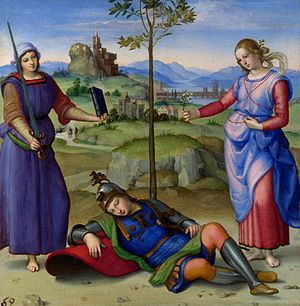Vision of a knight

|
| Vision of a knight |
|---|
| Raphael , ca.1504 |
| Egg tempera |
| 17.1 x 17.1 cm |
| National Gallery , London |
The vision of a knight or the dream of Scipio or allegory is a small egg tempera painting on poplar wood by the Italian Renaissance artist Raffael . It was completed in 1504 and is in the National Gallery in London. It was probably created together with the Three Graces , also 17 cm square, now in the Musée Condé des Château de Chantilly .
There are several theories about what the painting is supposed to represent. According to some art historians, the knight sleeping on his shield is the Roman general Scipio Africanus , who dreams that he has to choose between virtue (left, behind her a steep and rocky path) and pleasure (right, in a loose robe). However, the two female figures are not portrayed as opponents. They can represent the ideal qualities of the knight: the book, sword and flower they hold represent the ideals of learning, struggle and love that a knight should combine.
The most likely source for the allegory is from a passage in the Punica by the Latin poet Silius Italicus , an epic poem that tells of the Second Punic War .
The picture was brought to England in 1800 by the English art collector William Young Ottley.